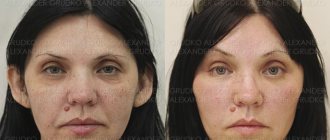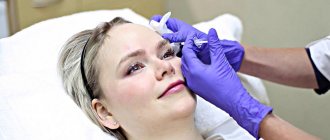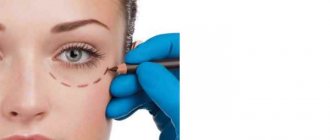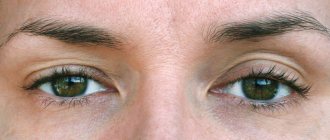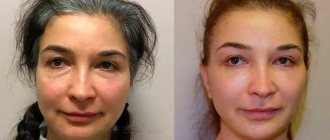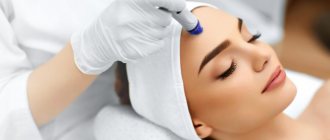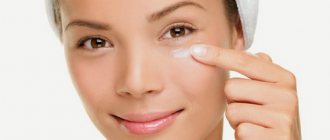What are periobital wrinkles?
Wrinkles in the periorbital area are age-related or facial changes around the eyes. They can appear even in very young people. The fact is that the skin in this area is very thin and, moreover, has few sebaceous glands, which is why it is most susceptible to various negative influences (such as dry air, incorrectly selected cosmetics, etc.).
In addition, each of us cannot do without regular blinking, and if we also have the habit of squinting, early wrinkles around the eyes are unlikely to be avoided.
Types of wrinkles
There is currently no single, unambiguously approved classification of wrinkles. However, cosmetologists and plastic surgeons have identified the main types of skin folds, the difference of which lies in their depth, causes and locations.
Depending on the type of wrinkles, a specific method of correcting them is selected. For example, Botox is used to smooth out wrinkles between the eyebrows, and the correction of wrinkles on the hands with the help of this drug is absolutely ineffective.
According to the depth of occurrence of wrinkles, they can be:
- superficial or epidermal: in the form of thin lines located in the epidermal layer of the skin. As a rule, their occurrence is due to insufficient hydration;
- mid-deep: reach the dermal layer of the skin. Their appearance is the result of the development and deepening of superficial (epidermal) wrinkles;
- deep: they look like pronounced raised folds. Changes affect the middle and deep layers of the skin and can reach the hypodermis.
Based on localization, wrinkles are divided into the following groups:
- on the forehead - in the form of horizontal lines, which are a direct consequence of human facial expressions. Another name is “anxious”, since their appearance is associated with emotions such as anger and excitement;
- between the eyebrows and on the bridge of the nose: “wrinkles of anger” or “proud wrinkles” - in the form of large vertical folds that appear when the eyebrows move or small folds on the upper part of the bridge of the nose;
- on the nose: the so-called “rabbit's feet” diverge from the central part of the bridge of the nose to the cheeks or lower eyelids. Visualized if a person squints or frowns;
- around the eyes - periorbital wrinkles: this type includes folds on the lower and upper eyelids and “crow’s feet” diverging from the outer corners of the eyes;
- nasolacrimal grooves: run from the inner corners of the eyes to the cheeks;
- on the cheeks: they may differ in the type and depth of skin deformation, which depends on the general anatomy of the face. They are most strongly visualized when a person smiles;
- nasolabial wrinkles: in the form of large creases that diverge from the wings of the nose to the corners of the lips;
- wrinkles around the lips: so-called “purse-string wrinkles” in the form of vertical folds located above the upper lip, sometimes under the lower lip, as well as folds diverging from the corners of the lips to the chin (“marionette” and wrinkles in the corners of the mouth);
- on the chin: age-related skin changes in the form of small irregularities;
- on the neck: “rings of Venus” in the form of long horizontal folds;
- on the back of the hands;
- in the décolleté area, etc.
Depending on the reason for the formation of wrinkles, they can be:
- facial – occur in areas of the skin that are closely connected with the facial muscles responsible for the expression of emotions;
- gravitational: nasolabial folds, drooping corners of the eyes and mouth, “puppets”, etc., formed as a result of sagging skin tissue;
- age-related (senile) - skin folds throughout the entire skin, which are the result of natural aging.
According to the nature of their behavior, wrinkles can be:
- dynamic - their appearance and disappearance depends on muscle activity; at rest they are not visualized;
- static – noticeable even at rest.
Correction of the periorbital area
Correction of the periorbital area is a common, but not the easiest task for cosmetologists. It requires careful adherence to precautions: after all, the risk of skin trauma is higher here compared to other areas of the face. In addition, constant facial activity contributes to the rapid appearance of new signs of aging.
Mesotherapy
Mesotherapy ensures the filling of wrinkles due to the active production of collagen and elastin, which begins after injections. In this case, the mesococktail is administered no higher than the bony edge of the orbit, otherwise there is a high risk of causing edema.
The advantages of the procedure include
- instant effect;
- multifunctionality;
- lack of rehabilitation period.
The drug Dermaheal (South Korea) provides an excellent effect for injection correction of the periorbital area. The procedure is carried out in a course and can be combined with other rejuvenating techniques: for example, with superficial peeling.
Filler
Fillers are effective even when folds in the skin are visible with a calm facial expression. Hyaluronic acid, which is most often used in this case, in addition to filling wrinkles, has another beneficial effect: it normalizes skin moisture and restores its elasticity.
Drugs are widely used at Novoklinik
- Juvederm (USA),
- Surgiderm (France),
- Yvoire (South Korea),
- Teosyal (Switzerland).
High-quality fillers allow you to achieve the desired result after the first procedure, however, they are gradually eliminated from the body, so after about a year the visit to the cosmetologist will need to be repeated.
Injections
Injections are still one of the most popular methods to combat wrinkles. You can remove crow's feet by injecting the drug into the outer corners of the eyelids. At the same time, if there is excess skin of the upper eyelids, this procedure must be carried out especially carefully so as not to cause ptosis.
Experienced Novoklinik specialists perform injections with the utmost care, so side effects as a result of this type of wrinkle correction are practically excluded.
The effect of botulinum toxin will become noticeable already 3-4 days after the procedure, and the maximum effect can be observed after two weeks. As a rule, the result lasts for about 6 months, after which the procedure (provided there are no contraindications) is recommended to be repeated.
Cosmetic procedures are contraindicated during pregnancy and lactation.
Correction of the lacrimal and palpebral grooves
Aesthetic correction of dark circles is carried out using a wide arsenal of therapy methods and often requires an integrated approach.
The choice of correction method depends on the etiology and pathogenesis of the problem. Identifying cause-and-effect relationships is important in the correction of the periorbital region.
The definition of “young look” includes a number of criteria: uniform color and texture of the skin around the eyes, absence of grooves (tear, palpebral, cheek-zygomatic) and fatty hernias of the lower and upper eyelids.
Fillers based on hyaluronic acid have proven their safety and effectiveness. Rare adverse events are associated exclusively with the technical nuances of the procedure.
The procedure for correcting the nasolacrimal groove is carried out with biodegradable fillers based on hyaluronic acid; the preparation for correcting such a delicate area must be quite soft and plastic.
The goal is to eliminate the volume deficit in the periorbital region. The choice of drug depends on the thickness of the skin and soft tissues. The drug is administered in small portions - 0.05 bonewise along the anterior (facial) surface of the zygomatic process of the maxillary bone and the lower orbital edge of the zygomatic bone.
When the filler is injected, the relief in the infraorbital area is leveled, the eyes do not look sunken, light reflection improves and dark circles under the eyes disappear.
Correction of this area requires the doctor to understand the mechanisms of formation of certain cosmetic defects, good knowledge of anatomy, and the ability to assess the individual and ethnic characteristics of the patient.
The procedure can be performed with either a needle or a cannula. The point for inserting the cannula is 1.5 cm below the temporal edge of the orbit. The depth of drug administration is strictly under the muscle. With intradermal administration, the risk of contouring increases. The filler is injected slowly and evenly into the projection of the palpebromalar groove. Subperiosteal administration guarantees a natural result, no Tyndall effect (change in skin color). The elevation test allows you to determine the level of the cannula.
You can increase the effectiveness of contouring of the periorbital area and prolong the effect by combining contouring with procedures aimed at tightening and toning the skin:
- fractional laser resurfacing;
- needle RF lifting;
- phototherapy;
- biorevitalization;
- plasma lifting;
- mesotherapy.
The main arteries supplying blood to the eye and periorbital area
The main artery providing blood supply to the eye is the orbital artery (OA) . The location of the multiple branches of the GA varies from patient to patient.
For example, in 3% of people the GA arises from the middle meningeal artery, a branch of the external rather than the internal carotid artery.
The GA supplies blood to two distinct areas – the orbital (mainly the eye socket) and the periorbital (mainly the muscles and area around the eyes) – see Table 1 .
Table 1: Branches of the ophthalmic artery supplying the eye and orbital region
The internal carotid artery , as a rule, passes through the cavernous sinus and before leaving it forms a branch - the orbital artery , which enters the orbit through the optic foramen.
The external carotid artery has two branches that supply blood to the orbit: the infraorbital and middle meningeal arteries.
Indications and contraindications
The procedure is performed on girls and women aged 25 to 40 years. The indications are :
- Drooping of the eyebrows and corners of the eyes.
- Presence of nasolabial folds.
- Expression wrinkles.
- Tired look.
Using this method, it is possible to correct some hereditary facial features. But the technique also has a number of contraindications , since it is performed under general anesthesia:
- Blood diseases.
- Pathologies of the cardiovascular system.
- Mental disorders.
- Pregnancy period.
- Inflammatory diseases.
- Periorbitoplasty cannot be performed for pathologies of the kidneys and liver that are in the acute stage.
What's happened
Fractional mesotherapy, or nanomesotherapy, is an injection method of restoring the skin , which includes a rejuvenating effect and the fight against stretch marks, enlarged pores and the effects of acne.
The specialist performs targeted microinjections in a specific area . Problem areas may be located at a distant distance from each other and occupy a small area.
The depth and number of microinjections determine the size of the area and the thickness of the skin. Thus, the dermis of the abdomen and thighs is much thicker and denser than the skin of the face or décolleté.
Carrying out at home
If there is no free time to visit a beauty salon, a woman can perform fractional mesotherapy at home. This requires:
- A special device that will be portable and easy to use. The device must be equipped with a nozzle that has several needles.
- Antiseptic for processing the nozzle.
- Products with a wound-healing effect : Panthenol cream is suitable for this.
- Local anesthetic : Dicaine, Aprovisol, Anestezin.
- Mesotherapy cocktail . It can come as a set with a mesoscooter, or be sold at a pharmacy.
Performance:
- The face is cleaned, wiped with anesthetic, and the nozzle of the device is disinfected.
- The cocktail is applied to the face.
- The mesoscooter massages problem areas for about 2 minutes.
- After 30 minutes, a wound healing medicine is applied.
- After 1 hour, a nourishing cream is applied.
It is important to remember that performing this procedure at home may not be as effective as in a beauty salon. The required cocktail can only be chosen by a specialist who relies on the individual characteristics of a woman’s skin.
Some more information about this procedure in the following video:
